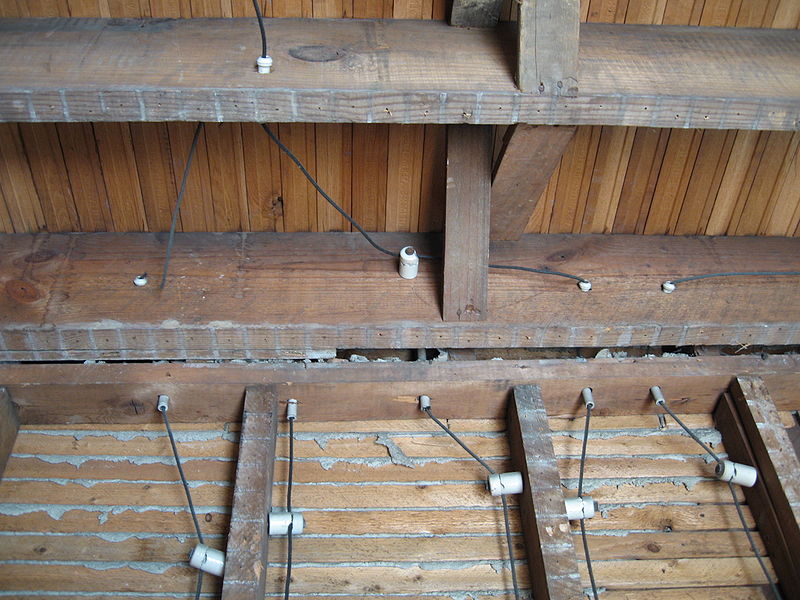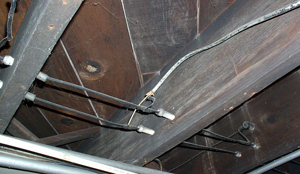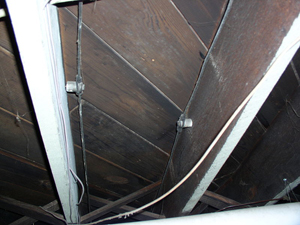|

 |
Knob and Tube Wiring and Aluminum Wiring have their own specific problems.
Knob and tube is very old wiring, and in many cases has deteriorated, cracked, or is missing insulation, which can lead to fires.
We have often seen wiring at light fixtures that has been damaged by high heat from a light fixture, in some cases even resulting in fires. The danger is that you cannot see what is behind the light fixture, and may not be aware of a problem until the damage is done.
We have also observed that homeowners will replace a 15 amp fuse that continuously blows, with a 20 Amp or even a 30 Amp fuse. This is very dangerous on wiring that was designed to safely carry only 15 amps. The results can be devastating; fire, loss of property, or worse even loss of life.
Rewiring the home is an investment that adds substantial value to your home. It is a major project that may take 1-3 weeks, depending on the size and construction of the home. It is the best solution to serve your long term interests.
|
|
ABOUT KNOB AND TUBE WIRING
Knob and tube wiring (sometimes abbreviated K&T) was an
early standardized method of electrical wiring in buildings, in common use in
North America from about 1880 to the 1930s. It consisted of single-insulated
copper conductors run within wall or ceiling cavities, passing through joist
and stud drill-holes via protective porcelain insulating tubes, and supported
along their length on nailed-down porcelain knob insulators.
Knob and tube wiring was eventually displaced from interior wiring systems because of the high cost of installation compared with use of power cables, which combined both power conductors of a circuit in one run (and which later included grounding conductors).
|
Where conductors entered a wiring device such as a lamp or switch, or were pulled into a wall, they were protected by flexible cloth insulating sleeving called loom. The first insulation was asphalt-saturated cotton cloth, then rubber became common. Wire splices in such installations were twisted together for good mechanical strength, then soldered and wrapped with rubber insulating tape and friction tape (asphalt saturated cloth), or made inside metal junction boxes.
|
 |
An example of early knob and tube wiring. Note ceramic tubes to carry wire through wooden joists; knob to support wire turning a corner; and (illegal) splice with more modern (1940s-era) Romex cable. |
 |
An example of early knob and tube wiring. One function of a knob was to prevent long runs of wire from sagging. Typically one short, unconnected piece of wire was used to tie the live wire to the knob |
Knob and Tube Wiring Hazards
"Knob and tube is very old wiring, at least 65 years old, and in many cases has deteriorated, cracked, or is missing insulation, which can lead to fires." (The International Association of Certified Home Inspectors) Below are nine important facts to know about knob and tube wiring. Being aware of the dangers of this type of wiring is the first step in making your home a safer place to live.
Often improperly altered creating dangerous connections or a system pushed beyond its limits.
Vulnerable to damage. When knocked or bent, wires can become dislodged or lose their insulation.
Insulation can become brittle with age, leaving bare wire exposed.
Can be damaged by rodents without homeowner's knowledge.
Not properly grounded.
May cause problems with homeowner's insurance.
|
KNOB AND TUBE WIRING FACTS
Knob and Tube Wiring does not meet today's electrical codes.
It uses free air to dissipate heat, so any contact with home insulation poses a threat of fire. (This is why many knob and tube homes were initially not insulated.)
Unable to carry electric load needed for many modern appliances.
DO YOU HAVE THIS TYPE OF WIRING IN YOUR HOME?
If you believe that you may have knob and tube wiring installed in your home, please call a licensed and certified electrician immediately. Rewiring is highly recommended. You and your family may be at high risk of shock, fire and/or electrocution. |
| |
|
|

